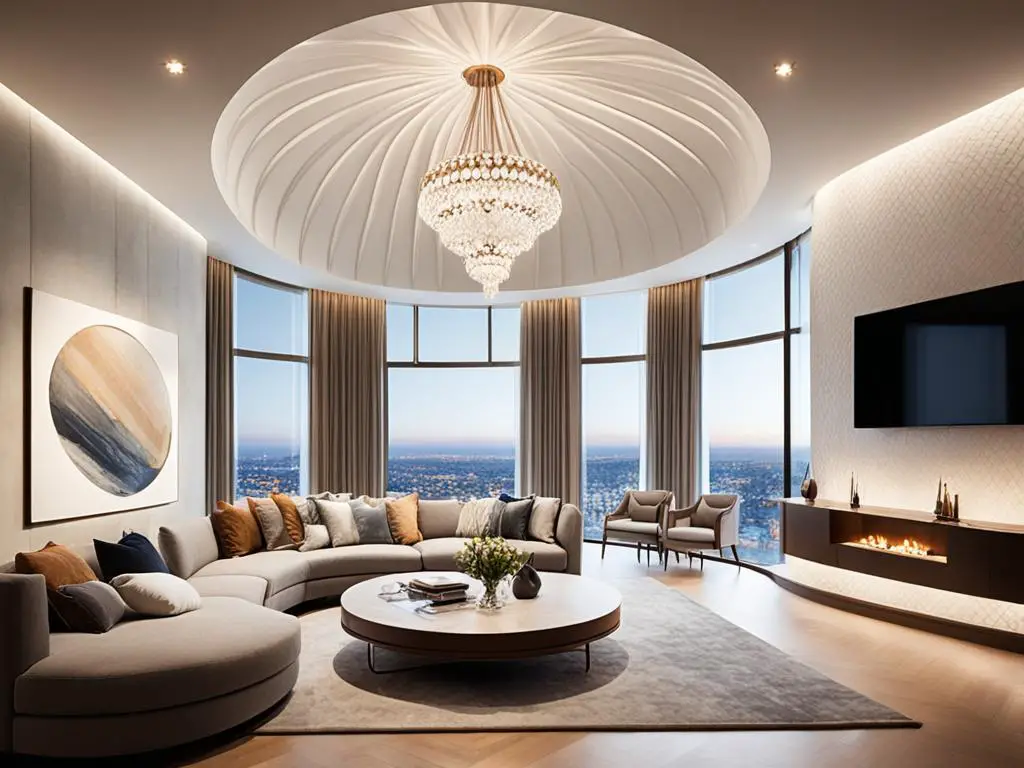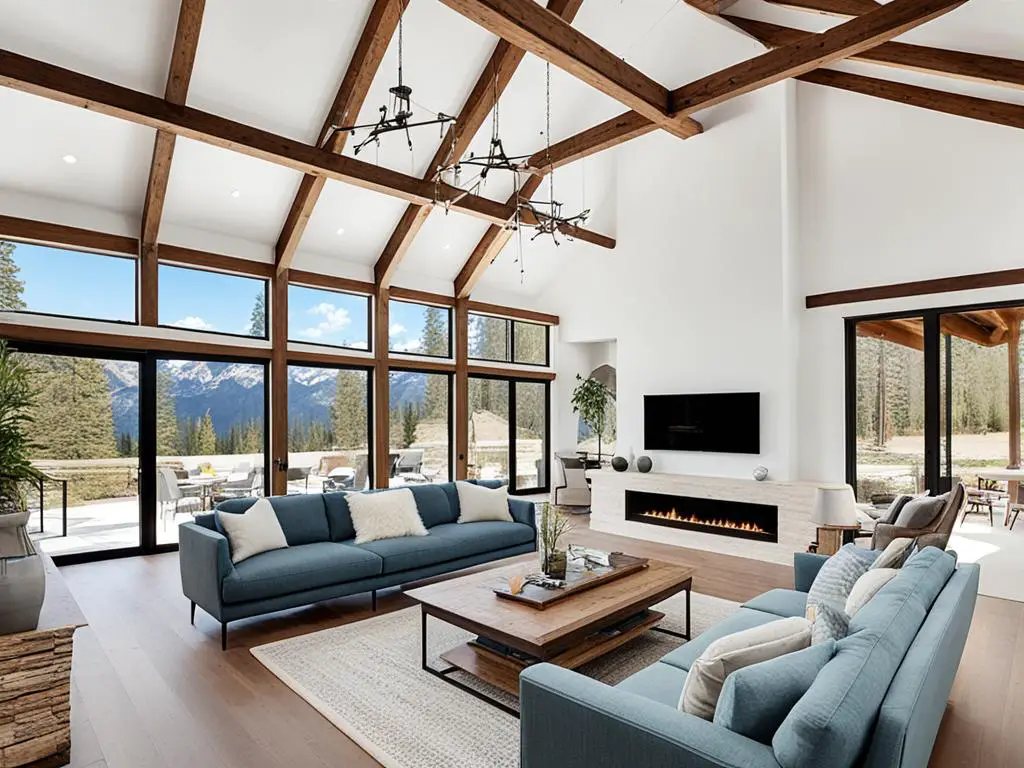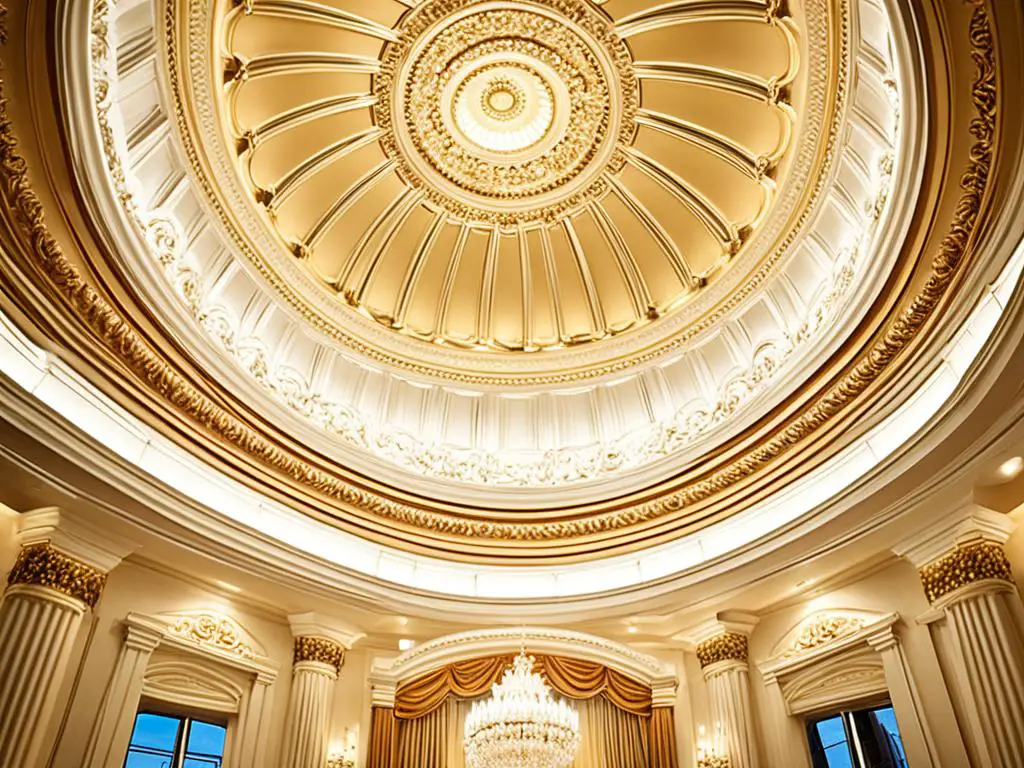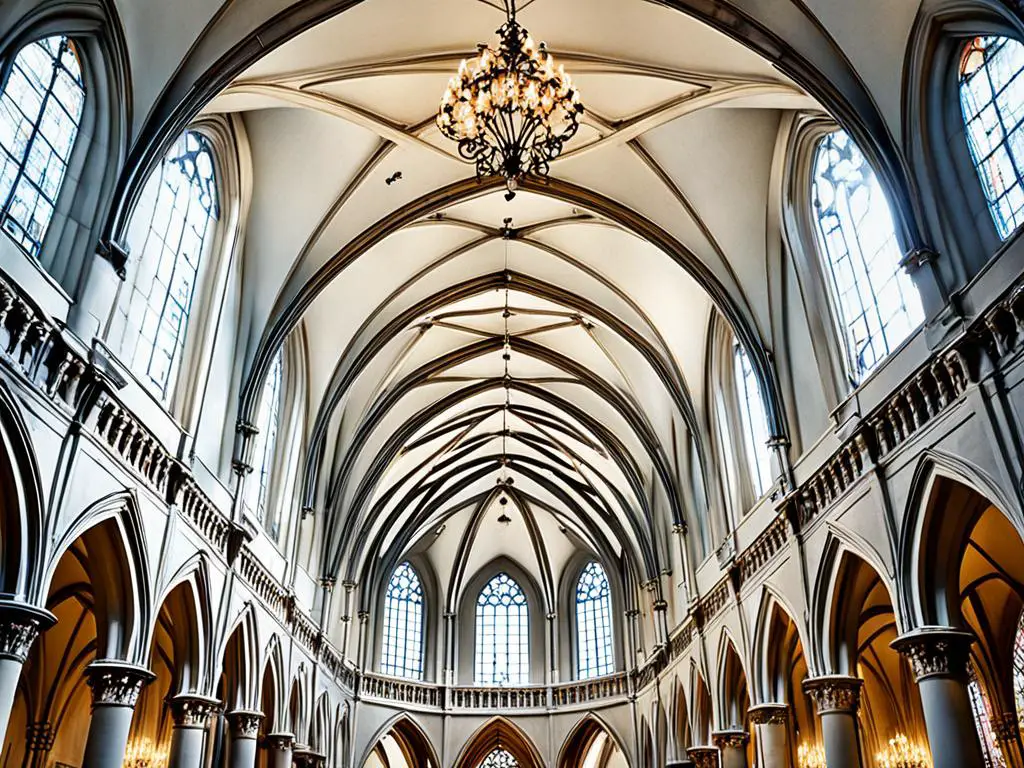When it comes to designing your home, the ceiling is an often overlooked but crucial element. It has the power to transform a space, adding dimension and architectural interest. Among the various ceiling types available, two popular choices are vaulted ceilings and tray ceilings. Each style brings its own unique charm and can greatly enhance the aesthetics of your home.
A tray ceiling features a raised central inset that creates a recessed “tray” effect. This design adds depth and visual interest to a room, making it appear taller and more spacious. On the other hand, a vaulted ceiling is characterized by its higher arch, drawing the eyes upward and creating an open and expansive feeling. Whether you prefer the elegant sophistication of a tray ceiling or the grandeur of a vaulted ceiling, the choice ultimately depends on your personal style and the specific characteristics of your space.
Key Takeaways:
- Vaulted ceilings and tray ceilings are two popular options when it comes to adding architectural interest to your space.
- A tray ceiling features a raised central inset, giving the illusion of a taller room.
- A vaulted ceiling has a higher arch that creates an open and spacious feeling.
- Consider your overall design aesthetic, the size of your space, and your personal preferences when choosing between these two styles.
- Both vaulted and tray ceilings can be customized further to suit your unique taste and enhance the overall look of your home.
The Tray Ceiling
A tray ceiling is a type of ceiling design that adds depth and visual interest to a room. It features a central section that is raised higher than the surrounding areas, creating a recessed “tray” effect. This design gives the illusion of a taller space, making the room feel more spacious and open.
Tray ceilings can be further enhanced with specialty molding or integrated lights, adding an extra touch of elegance and sophistication to the room. The raised central inset creates a focal point and draws the eyes upward, making the space feel more dynamic and visually appealing.
The Vaulted Ceiling
A vaulted ceiling is characterized by a higher arch that draws the eyes upward. It is typically found in larger homes and creates an open and spacious feeling.
There are different types of vaulted ceilings, each adding its own unique dimension to a space:
- Cathedral Vaulted Ceilings: These ceilings feature symmetrical sloping sides that create a sense of grandeur and elegance. They are often seen in churches and traditional architectural designs.
- Barrel-Vaulted Ceilings: With a curved arch resembling an upside-down barrel, this type of vaulted ceiling adds a touch of drama and sophistication to any room. It can be particularly striking in entryways and dining areas.
- Groin-Vaulted Ceilings: These ceilings are characterized by intersecting ribs that create a stunning geometric pattern. They are commonly found in Romanesque and Gothic architecture and can add a sense of architectural interest to a space.
With their higher arch, vaulted ceilings offer not only a visually appealing design but also an open and airy atmosphere. They create a sense of grandeur and can make ceilings in larger homes feel even higher. Whether you choose a cathedral, barrel-vaulted, or groin-vaulted ceiling, the result is an open feeling that adds sophistication to your space.

Quote from an Architect:
“Vaulted ceilings have the power to transform a room. The upward arch draws the eyes upward, creating a sense of grandeur and spaciousness. It’s a ceiling design that never fails to impress.”
Pros and Cons of Tray Ceilings
Tray ceilings, also known as recessed ceilings, offer homeowners a unique design option to enhance their living spaces. Like any architectural feature, tray ceilings have their advantages and drawbacks. Let’s take a closer look at the pros and cons of choosing tray ceilings for your home.
Pros of Tray Ceilings:
- Enhanced aesthetics: Tray ceilings add depth and architectural interest to a room, creating a visually appealing focal point.
- Accommodate ceiling fans: Unlike some other ceiling designs, tray ceilings can accommodate ceiling fans, providing both functional and decorative benefits.
- Natural light: The recessed portion of a tray ceiling can act as a light shelf, allowing for more natural light to enter the space.
Cons of Tray Ceilings:
- Dated aesthetic: Some individuals may consider tray ceilings to be outdated or associated with older home designs.
- Height restrictions: In rooms with lower ceilings, a tray ceiling may not be feasible, as it can make the room feel more cramped.
- Effectiveness of ceiling fans: There are accounts of ceiling fans being less effective in tray ceilings due to the recessed design.
When deciding whether a tray ceiling is right for your space, it’s crucial to weigh these pros and cons based on your personal preferences and the specific characteristics of your home.
“Tray ceilings provide an elegant and stylish addition to a room, allowing for a unique and eye-catching design. However, it’s essential to consider the potential drawbacks, such as the dated aesthetic and limitations in rooms with lower ceilings.” – Interior Design Expert
To help you further understand the pros and cons of tray ceilings, take a look at the table below:
| Pros | Cons |
|---|---|
| Enhanced aesthetics | Dated aesthetic |
| Accommodate ceiling fans | Height restrictions |
| Natural light | Effectiveness of ceiling fans |
Pros and Cons of Vaulted Ceilings
Vaulted ceilings offer their own set of advantages and disadvantages. On the positive side, vaulted ceilings create architectural interest and can make a room feel grand and spacious. The elevated height and sloping angles of the ceiling draw the eyes upward, adding a sense of drama and elegance to the space. This architectural feature can be particularly beneficial in rooms with larger dimensions, as it helps to fill the vertical space and create a visually striking atmosphere.
Vaulted ceilings also provide excellent ventilation for hot rooms. The increased ceiling height allows hot air to rise and circulate more effectively, improving airflow and promoting a cooler environment. This natural ventilation can be especially beneficial in warmer climates or during the summer months.
However, it’s important to consider the potential drawbacks of vaulted ceilings. In homes with lower ceilings, vaulted ceilings may not be suitable as they can make a space feel cavernous or less intimate. The grandeur of a vaulted ceiling may overpower smaller rooms, potentially diminishing their coziness and sense of comfort. It’s essential to strike a balance between the ceiling height and the overall proportions of the space to ensure a harmonious and inviting atmosphere.

| Pros of Vaulted Ceilings | Cons of Vaulted Ceilings |
|---|---|
| Creates architectural interest | May make a space feel cavernous in smaller rooms |
| Makes a room feel grand and spacious | Could diminish the sense of coziness in certain spaces |
| Enhances ventilation and airflow | Not suitable for homes with lower ceilings |
Choosing the Right Ceiling Style
When it comes to selecting the perfect ceiling style for your home, it’s important to consider several factors, including your overall design aesthetic, the size of your space, and your personal preferences. Two popular options to explore are vaulted ceilings and tray ceilings, each offering unique advantages and considerations.
Vaulted ceilings, with their higher arch and open feeling, are better suited for larger homes with ample ceiling height. They create a sense of grandeur and provide a spacious atmosphere. On the other hand, tray ceilings can work well in various room sizes and architectural styles. These ceilings feature a raised central inset, adding depth and visual interest to the space while creating the illusion of a taller room.
It’s important to also take into account other factors such as pitched roof interiors or slanted ceilings, as these can impact your ceiling design choices. By considering these elements, you can ensure that your chosen ceiling style harmonizes with the overall architecture and enhances the aesthetic appeal of your space.
Below is a table summarizing the key characteristics of vaulted ceilings and tray ceilings, to help you make an informed decision:
| Aspect | Vaulted Ceilings | Tray Ceilings |
|---|---|---|
| Design | Higher arch, open feeling | Raised central inset, illusion of taller room |
| Suitability | Best for larger homes with high ceilings | Works well in various room sizes and architectural styles |
| Pitched Roof Interiors | Complement pitched roof interiors | Can be adapted to accommodate pitched roof interiors |
| Slanted Ceilings | Not suitable for slanted ceilings | Can work with slanted ceilings |
By weighing these factors against your preferences, you can choose the ceiling style that best complements your home’s design and reflects your personal taste.
Customizing Your Ceiling Design
Whichever ceiling style you choose, there are several ways to customize your design further. The possibilities are endless when it comes to adding unique touches that reflect your personal style and elevate the aesthetics of your space.
Dome Ceiling

A dome ceiling is a stunning choice that adds drama and height to any room. It creates a focal point and brings a sense of grandeur to the space. Dome ceilings can be customized with intricate plasterwork or decorative painting, allowing you to create a truly unique and eye-catching design. Whether you want a classical or modern look, a dome ceiling is sure to make a statement.
Coffered Ceiling
A coffered ceiling is a timeless option that adds depth and elegance to a room. It features a grid of recessed panels or beams, creating a three-dimensional effect. The woodwork adds warmth and a touch of sophistication to the space. Coffered ceilings can be customized with different panel sizes, shapes, and finishes to suit your style. This ceiling design works well in both traditional and contemporary settings, adding a sense of architectural charm.
Exposed Beam Ceilings
Exposed beam ceilings are perfect for those who prefer a rustic or industrial look. They add character and a sense of openness to a room. Exposed beams can be made of wood or metal, and they can be left in their natural state or painted to match your desired aesthetic. Whether you want to achieve a cozy cottage feel or a modern farmhouse look, exposed beam ceilings can be customized to create the atmosphere you desire.
Explore different customization options to make your ceiling truly unique and tailored to your style. From grand dome ceilings to elegant coffered ceilings and rustic exposed beam ceilings, there’s a design that will enhance the overall look and feel of your space.
Conclusion
When it comes to ceiling design options, choosing between vaulted ceilings and tray ceilings allows you to elevate your home’s aesthetics. Both ceiling types have their merits and can greatly enhance the overall visual appeal of your space.
It’s important to consider the specific characteristics of your home and your personal style when making this decision. Vaulted ceilings, with their higher arch and open feeling, are best suited for larger homes and those seeking a spacious ambiance. On the other hand, tray ceilings, with their raised central inset, create depth and the illusion of a taller room, making them suitable for various room sizes.
Before finalizing your decision, weigh the pros and cons of each ceiling type. Tray ceilings offer the advantage of accommodating ceiling fans and allowing more natural light to enter, while some people find the look to be dated. Vaulted ceilings provide architectural interest and excellent ventilation, but can sometimes make smaller spaces feel too cavernous.
No matter which ceiling style you choose, there are numerous customization options available to make it unique to your taste. Consider options like dome ceilings, coffered ceilings, and exposed beam ceilings to add drama, elegance, or rustic charm to your space.
By carefully considering your preferences, the characteristics of your home, and the available customization options, you can make an informed decision that will not only elevate your home’s aesthetics but also create a space that truly reflects your style and preferences.
FAQ
What is the difference between a vaulted ceiling and a tray ceiling?
A tray ceiling has a raised central section that creates a recessed “tray” effect, while a vaulted ceiling has a higher arch that draws the eyes upward.
What is the purpose of a tray ceiling?
A tray ceiling adds depth and visual interest to a room, creating the illusion of a taller space.
What are the advantages of a vaulted ceiling?
A vaulted ceiling creates an open and spacious feeling, provides excellent ventilation, and adds architectural interest to a room.
Can tray ceilings accommodate ceiling fans?
Yes, tray ceilings can accommodate ceiling fans and bring in more natural light.
Are tray ceilings considered dated?
While some people may find the look of tray ceilings to be dated, it ultimately depends on personal preference and the overall design aesthetic.
Are vaulted ceilings suitable for every home?
Vaulted ceilings may not be suitable for every home, especially those with lower ceilings, as they can sometimes make a space feel cavernous or less intimate.
Which ceiling style is better suited for larger homes?
Vaulted ceilings are better suited for larger homes with ample ceiling height.
Can tray ceilings work well in various room sizes and architectural styles?
Yes, tray ceilings can work well in various room sizes and architectural styles.
What are some other factors to consider when selecting a ceiling style?
Other factors to consider include pitched roof interiors, slanted ceilings, and the overall design aesthetic and personal preferences.
How can I customize my ceiling design further?
You can customize your ceiling design further by adding a dome ceiling for drama and height, a coffered ceiling for depth and elegance, or exposed beam ceilings for rustic charm.
Which ceiling style should I choose?
The choice between a vaulted ceiling and a tray ceiling depends on your personal style, the specific characteristics of your home, and your preferences. Consider the pros and cons, as well as the available customization options, to make an informed decision.




